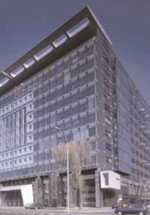Glass Tints

Body tinted glass products are produced by small additions of metal oxides to the float or rolled glass composition. These small additions colour the glass bronze, green, blue or grey but do not affect the basic properties of the glass except for changes in the solar energy transmission. The colour is homogeneous throughout the thickness.
Most flat glass products contain small amounts of iron which produces a green tint usually only perceived when the glass pane is viewed 'on edge'. Additional constituents can be added to the glass composition to produce various specific colours, for example: additional iron is used to produce green tints, cobalt and iron for blue tints or iron, cobalt and selenium for bronze or neutral (grey) tints.
These products are perceived as giving weak colours by transmitted light. They do not produce high or significantly coloured reflectances. Usually their principal external visual characteristic is their lower light transmission. Coated glass products with high light reflectances can exhibit stronger exterior colours than those of body tinted glass.
Transmitted light through the glass, from the building interior, diminishes the perceived effect of these reflected external colours of coated glass. Conversely, such light increases the perceived transmitted colours. Since most coated reflective glass products also exhibit colour by transmission, the transmitted coloured light from the building interior will also be seen externally in conjunction with the reflected colours producing complicated colour appearances.
To view our full range of solar-control and tinted glass click here.